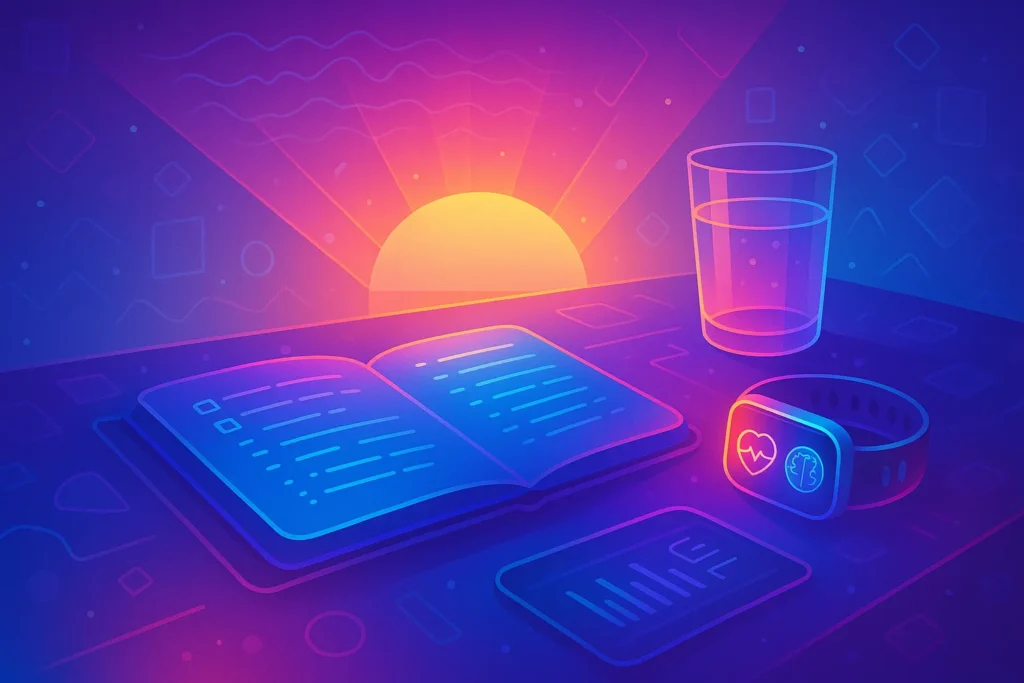Introduction: The Critical Window of Morning Productivity
Your morning is not just the first part of your day—it’s a biological reset button. Neuroscience shows that what you do in the first 1–3 hours after waking directly influences focus, motivation, and decision-making throughout the day. This window, shaped by circadian rhythms, hormone cycles, and neurochemical states, creates the perfect stage for either peak performance—or wasted potential.
When you scroll your phone first thing, skip breakfast, or ignore sunlight, you’re working against your biology. But when you align your routine with science, mornings become your greatest productivity advantage.
💡 Think of your morning as programming your brain’s operating system. Do it right, and the whole day runs smoother.
Circadian Rhythms: Your Brain’s Biological Clock
Every cell in your body follows circadian rhythms—24-hour cycles influenced by light and darkness. Neuroscience research shows that cortisol, the body’s natural “wake-up” hormone, spikes in the morning, priming your system for alertness and focus.
When you expose yourself to natural light early in the day, you reinforce these rhythms. Morning sunlight signals the brain’s suprachiasmatic nucleus (SCN) to release cortisol at the right time and set your internal clock for the next cycle. This not only enhances alertness but also improves sleep quality that night.
Ignoring light exposure—or worse, starting your day with only artificial indoor light—confuses this system. It’s why digital nomads, students, and remote workers who skip morning light often report brain fog and irregular energy.
👉 For a deeper dive on structuring rhythms, see our guide on How to Build a Daily Routine That Actually Sticks.
Dopamine and Motivation: The Science of Small Wins
Motivation is less about willpower and more about dopamine—the brain’s reward chemical. Neuroscience shows that small, immediate wins in the morning create a dopamine cascade that boosts motivation for larger tasks later.
Simple actions like:
-
Making your bed (instant accomplishment).
-
Drinking water and stepping outside (dopamine + circadian alignment).
-
Journaling a short task list (clarity-driven dopamine hit).
These micro-wins activate the striatum, part of the brain’s reward circuit, reinforcing a sense of progress. This primes you to tackle deeper work without the procrastination spiral.
Contrast this with dopamine hijacks like checking social media notifications first thing. The brain gets an instant but hollow dopamine hit, dulling motivation for real work.
👉 Want to understand how to protect your dopamine from distractions? Our article Mastering Focus in the Age of Digital Distractions explores strategies in depth.
Neuroplasticity: Morning as a Learning Window
Neuroplasticity—the brain’s ability to form new connections—is strongest in the early hours after waking. Cortisol and norepinephrine, naturally elevated in the morning, increase alertness and enhance the brain’s readiness to encode new skills.
This makes mornings ideal for:
-
Language learning.
-
Practicing a new instrument.
-
Skill-based professional training.
Studies show that pairing morning learning sessions with a short nap or evening sleep enhances memory consolidation. Essentially, mornings aren’t just for productivity—they’re prime for brain rewiring.
👉 If you’re serious about time structuring, check our Beginner’s Guide to Time Blocking for Focus and Flow for science-based scheduling.
Sleep and Recovery: Your Morning Starts the Night Before
Neuroscience emphasizes that mornings don’t exist in isolation. The quality of your previous night’s sleep directly impacts hormone release, cognitive sharpness, and energy availability at sunrise.
Poor sleep reduces slow-wave activity, limiting recovery for the hippocampus (your brain’s memory hub). This explains why skipping rest leads to sluggish mornings and weak recall. On the flip side, a solid 7–9 hours of sleep creates optimal conditions for the morning cortisol peak, dopamine readiness, and neuroplastic learning.
In practical terms: optimizing your morning means optimizing your night before—consistent sleep-wake cycles, reduced blue light before bed, and mindful recovery.
👉 Dive deeper into biological productivity drivers in The Science of Productivity: What Actually Works.
Want Science-Backed Productivity Tips?
Join our free newsletter and get neuroscience-driven productivity tactics, tech tools, and routines delivered weekly.
No spam. Just smarter mornings and sharper focus.
100% privacy. No noise. Just value-packed insights from NerdChips.
A Neuroscience-Backed Morning Framework
Let’s put the science into practice. Here’s a framework to structure your morning around proven brain principles:
1. Light Exposure
Within 30 minutes of waking, get natural sunlight or use a sunrise alarm clock. This locks your circadian rhythm, boosts cortisol at the right time, and signals melatonin shutdown.
2. Movement
Exercise increases Brain-Derived Neurotrophic Factor (BDNF), a neurochemical that supports learning and plasticity. Even 10–15 minutes of aerobic movement primes the brain for cognitive performance.
3. Journaling and Goal-Setting
Writing activates the prefrontal cortex, sharpening focus and emotional regulation. A short daily log or gratitude entry enhances dopamine motivation loops.
4. Strategic Nutrition and Hydration
Rehydration first (water with electrolytes), then a balanced breakfast with protein and complex carbs supports glucose stability, avoiding mid-morning crashes.
5. Avoid Dopamine Hijacks
Resist checking email or social media first thing. Instead, allocate your brain’s dopamine surge to learning, deep work, or creative problem-solving.
🎨 5 Neuroscience-Backed Habits to Start Every Morning
-
✅ Step into sunlight within 30 minutes of waking.
-
✅ Move your body—short workout or stretching.
-
✅ Rehydrate before caffeine.
-
✅ Write down 1–3 goals to anchor focus.
-
✅ Delay social media until after deep work.
📌 You don’t need to wake up at 5 AM. You need to wake up in alignment with your biology.
🎨 Morning Routine Myth-Busting
Myth: You must wake up at 5 AM to be successful.
Reality: Neuroscience shows productivity depends more on aligning with your personal chronotype (early bird vs night owl) than arbitrary wake-up times. What matters is consistency, light exposure, and how you use your morning window.
Tools That Support Neuroscience-Backed Routines
Science is the foundation, but smart tools can make implementation easier:
-
Wearables like Oura Ring or Fitbit Charge track sleep and readiness, ensuring you optimize recovery.
-
Sunrise alarm clocks mimic natural light for circadian rhythm alignment.
-
Mindfulness apps such as Headspace or Calm help regulate stress chemistry.
-
Supplements like Vitamin D (for light-limited environments) and L-theanine for focus can support morning cognition.
👉 For tech-driven mindfulness tools, see our review on Mindfulness Tech: Apps & Gadgets for Stress-Free Productivity.
Chronotypes & Personalization: Not Everyone Needs 5 AM
One of the biggest misconceptions about morning routines is that success requires waking up at the crack of dawn. Neuroscience actually shows that chronotypes—your natural sleep-wake tendencies—vary across individuals. Roughly 20% of people are “larks” (early risers), 20% are “owls” (late sleepers), and the rest fall somewhere in between.
Your chronotype is influenced by genetic factors like the PER3 gene, which regulates circadian rhythms. Fighting against it often leads to chronic fatigue and reduced productivity. Instead, you should align your morning routine with your biology.
-
Early birds benefit from structured, creative work in the morning and wind down earlier.
-
Night owls may use mornings for lighter routines like light exposure, stretching, and journaling, saving deep work for later in the day.
-
Intermediates have flexibility but should still anchor mornings with sunlight and hydration.
📌 Consistency matters more than the clock. Your best morning routine is the one that aligns with your chronotype.
The Neuroscience of Morning Movement
Exercise isn’t just about muscles—it’s about the brain. Movement in the morning triggers a surge of Brain-Derived Neurotrophic Factor (BDNF), often described as “fertilizer for the brain.” BDNF strengthens synaptic connections, enhancing learning and memory formation throughout the day.
Morning workouts also increase serotonin and endorphins, neurochemicals linked to mood stability and motivation. This combination primes the brain for focus while reducing stress and anxiety. Even short bouts of 10–15 minutes of exercise—yoga, brisk walking, or push-ups—are enough to produce measurable neurological benefits.
Neuroscience also shows timing matters: exercising early avoids the cortisol spike that can happen with late-night workouts, which may interfere with sleep. In other words, morning movement is both a performance booster and a sleep regulator.
Nutrition & Brain Chemistry in the Morning
What you eat in the morning shapes your brain chemistry for the next several hours. A protein-rich breakfast increases levels of tyrosine, a precursor to dopamine and norepinephrine. These neurotransmitters are vital for focus, decision-making, and sustained motivation.
In contrast, a high-sugar breakfast causes a glucose spike followed by a crash, leading to irritability and brain fog. Healthy fats like omega-3s further support acetylcholine production, improving memory and cognitive clarity.
Neuroscientists recommend simple formulas like:
-
Eggs or Greek yogurt (protein).
-
Whole grains or fruit (complex carbs).
-
Nuts, seeds, or avocado (healthy fats).
Hydration is just as important. After 7–9 hours of sleep, dehydration impairs cognitive performance. A glass of water before coffee helps restore fluid balance and supports optimal neurotransmission.
📌 Think of breakfast as brain fuel, not just body fuel.
Mindfulness & Breathwork: Calming the Amygdala
Mornings often come with a flood of mental chatter—what neuroscientists call amygdala overactivity. Left unchecked, this can create anxiety and reactive behavior that undermines focus.
Even five minutes of mindfulness or breathwork activates the prefrontal cortex, which governs planning and self-control, while calming the amygdala. Practices like box breathing (inhale 4, hold 4, exhale 4, hold 4) reduce cortisol and create a baseline of calm alertness.
Neuroimaging studies show that regular mindfulness strengthens the anterior cingulate cortex, improving attention regulation. In practical terms, it means you’re less likely to get derailed by distractions.
👉 Explore tools in our review of Mindfulness Tech: Apps & Gadgets for Stress-Free Productivity to make this practice easier.
Case Studies: Small Changes, Big Results
Case 1: The Remote Worker
Sarah, a freelance designer, used to start her day scrolling Slack and emails. By shifting to 10 minutes of sunlight, journaling 3 priorities, and a short yoga session, she reported a 30% increase in project completion rates within two months.
Case 2: The Graduate Student
Ravi struggled with memory retention during morning study sessions. Adding a 15-minute run followed by protein-rich breakfast boosted his exam scores significantly. He credited the combination of exercise-induced BDNF and stable glucose levels.
Case 3: The Entrepreneur
Luis implemented a no-phone-first-hour rule, replacing it with breathwork and goal-setting. He described feeling “mentally sharper and less scattered,” leading to faster decision-making during critical meetings.
📌 These aren’t magic tricks—they’re simple neuroscience-aligned tweaks that compound into big outcomes.
Advanced Layer: Nootropics & Wearables
For those ready to take morning optimization further, advanced tools offer additional leverage:
-
Nootropics & Supplements: Vitamin D supports circadian health, Omega-3 fatty acids aid synaptic plasticity, and compounds like L-theanine promote calm focus when paired with caffeine.
-
Wearables: Devices like the Oura Ring or Fitbit track sleep stages and readiness scores, helping you fine-tune your bedtime so mornings feel lighter and more energized.
-
Data-Driven Adjustments: Apps that sync biometrics to behavior logs let you experiment with different morning routines and see what produces the highest focus or energy scores.
The key is to use these tools to amplify core neuroscience principles, not replace them. Technology works best when it complements biology.
🧠 Nerd Verdict
Morning routines aren’t motivational fluff—they’re biological leverage points. Neuroscience proves that aligning with circadian rhythms, leveraging dopamine, and protecting your brain’s plasticity window sets the stage for peak productivity.
Instead of copying someone else’s 20-step ritual, design a science-backed morning routine that matches your biology and goals. The result isn’t just more output—it’s sustainable focus, energy, and learning power.
❓ FAQ: Nerds Ask, We Answer
💬 Would You Bite?
What’s the one change you’d make to your mornings if neuroscience guaranteed it would double your focus for the day?



